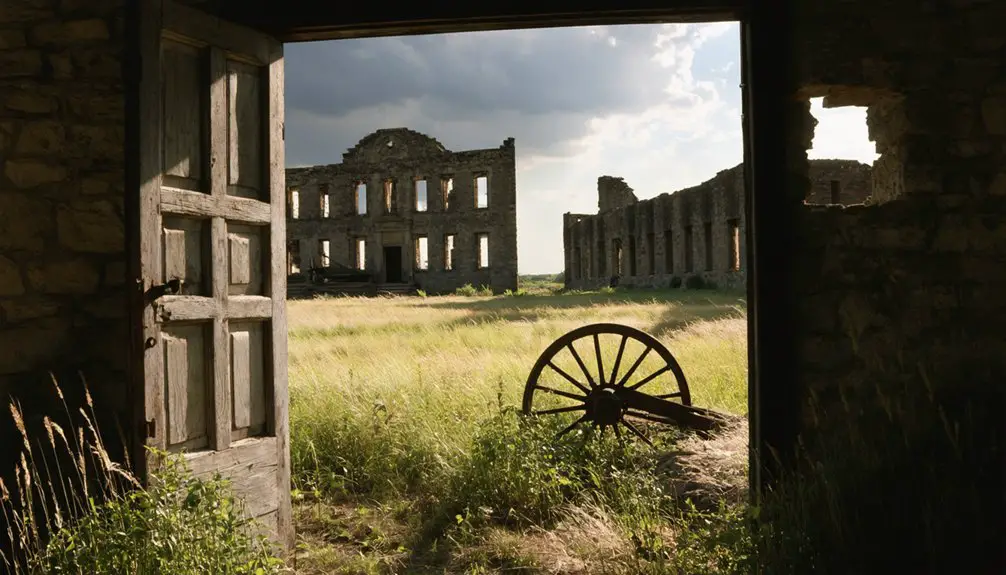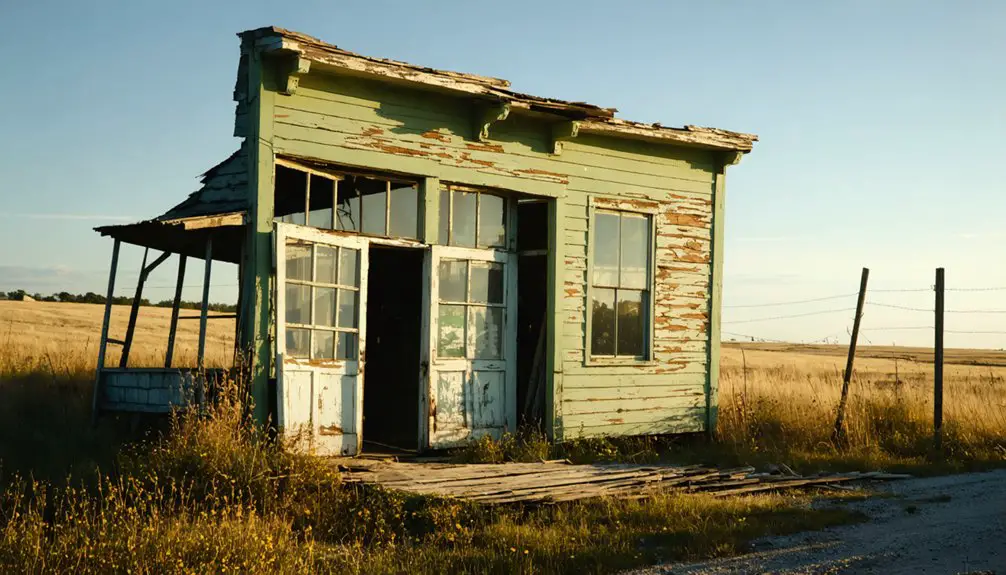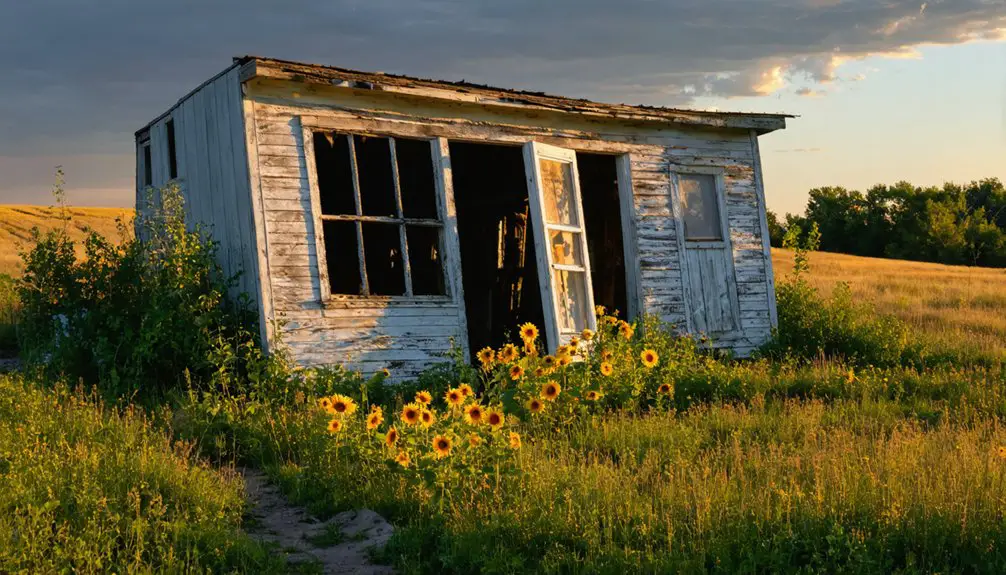You’ll find Voorhees in Stevens County, Kansas, where it emerged during the 1886-1887 frontier land boom along the Santa Fe railroad line. This ghost town witnessed the violent county seat wars between rival settlements Hugoton and Woodsdale, which ultimately led to its decline. The town’s post office closed in 1893, marking the end of municipal services and triggering an exodus of residents. Its abandoned structures and rich history hold countless untold stories of Kansas’ tumultuous frontier era.
Key Takeaways
- Voorhees was established during Kansas’ 1886-1887 land boom along the Santa Fe railroad line as a frontier settlement.
- The town’s strategic location near the Oregon Trail and limestone quarrying operations initially drove its economic development.
- Visitors today must prepare for exploring deteriorating structures with basic supplies and emergency gear, using Hugoton as their base.
- The post office closed in 1893, triggering mass exodus, though the brick building remained operational until 2015 under ZIP 66850.
- Properties were legally considered abandoned after 45 days of neglect, with owners retaining reclamation rights under Kansas law.
The Birth of a Frontier Settlement
While the great land boom of 1886-1887 swept across western Kansas, frontier settlements began emerging rapidly along the Santa Fe railroad line, transforming the high, dry plains into a patchwork of ambitious townships.
The early pioneers relied heavily on pack-trains and wagons to establish supply routes between settlements. You’d have witnessed raw boom towns sprouting almost overnight, their unpainted boards and tent structures testifying to settlers’ determination to overcome frontier challenges. Woodsdale and Hugoton emerged as fierce rivals during this period of rapid development.
These pioneers, including eastern immigrants and southern blacks, weren’t deterred by the uncertain farming conditions. They’d come by rail and wagon, driven by settlement motivations ranging from commercial prospects to the promise of fresh starts away from crowded eastern regions.
Driven by dreams of prosperity and new beginnings, settlers braved the untamed frontier despite its uncertain promises and harsh realities.
The competition was fierce among these nascent communities, each vying to become a regional economic hub. Despite the harsh terrain and sporadic military protection, settlers pressed on, establishing commercial outposts in their quest for opportunity.
Life in Early Stevens County
The fledgling Stevens County of the 1880s embodied the raw spirit of Kansas frontier life. You’d have found a mix of determined settlers, mostly from McPherson, Kansas, carving out their futures amid the untamed prairie.
The community dynamics were complex – while some towns like Lafayette sprouted from peaceful Quaker roots, you’d have witnessed fierce rivalries, especially in the violent county seat wars between Hugoton and Woodsdale. The Beaty Brothers brought the first cattle herd to the area in 1880, marking the start of ranching in the region. The county’s early years were marked by reorganization when it merged with Seward in 1881.
Life wasn’t easy for these pioneers. Your settler experience would’ve meant adapting to harsh conditions while building essential institutions.
As the population surged to 2,600 by 1886, you’d have seen the emergence of courts, schools, and churches. Yet by 1900, economic hardship had driven many away, leaving just 620 residents to maintain their stake in this challenging frontier.
County Seat Wars and Local Tensions

You’ll find the local tensions in Stevens County erupted into violence when Hugoton and Woodsdale, just eight miles apart, battled fiercely over the county seat designation in 1886-1888.
The stakes intensified after Hugoton Marshal Sam Robinson’s altercation with a Woodsdale undersheriff in Voorhees, leading to armed posses, gunfights, and ultimately the Hay Meadow Massacre where Woodsdale deputies killed several Hugoton lawmen near the Kansas-Oklahoma border.
The county seat fight was reminiscent of the Coronado-Leoti conflict, which had become Kansas’ bloodiest county seat war.
Law enforcement officials aligned themselves with their respective towns, transforming what began as a political power struggle over railroad routes and economic benefits into a deadly feud that required Kansas militia intervention. The violence continued until 1891 when Colonel Woods’ assassination effectively ended Woodsdale’s influence in the region.
Violence Between Rival Towns
During the late 1880s, violent county seat wars erupted across Kansas as rival towns fought for political dominance and economic survival.
Town rivalries frequently escalated into armed conflicts, with the Battle of Cimarron in 1889 standing as a prime example. You’ll find that these disputes turned deadly when Bill Tilghman and his deputized forces clashed with Cimarron residents over county records, leaving one dead and seven wounded. The battle lasted six intense hours before finally ending after a telegraph from Bat Masterson arrived. Wealthy businessman Asa T. Soule influenced these conflicts by financing the town of Ingalls to compete against Cimarron.
Similar patterns of violence emerged across Kansas counties, where prominent lawmen like Bat Masterson and Wyatt Earp took sides in these territorial feuds.
Local militias formed, elections were conducted at gunpoint, and rival towns launched raids to seize county records by force.
Even Colorado wasn’t immune – Grand County’s 1883 shootout claimed four lives, including three county commissioners.
Political Power Struggles Intensify
Beneath the surface of armed conflicts between rival Kansas towns lay intricate political power struggles, particularly evident in Stevens County’s bitter county seat war.
You’d find Hugoton and Woodsdale locked in fierce competition, with political alliances forming and fracturing as each town vied for county seat status.
After Hugoton’s temporary designation in 1886, election fraud allegations exploded. The Kansas legislature favored Hugoton despite Supreme Court findings of perjury, while Woodsdale fought back through legal channels.
When tensions peaked during vote counting, the state deployed militia forces under General Murrey Myers to restore order. The conflict turned deadly when Hugoton men ambushed a group of Woodland citizens in a hay meadow.
Railroad bond elections became another battleground, with Hugoton interests sabotaging plans that would’ve benefited Woodsdale.
Law Enforcement Takes Sides
As law enforcement became entangled in Kansas county seat disputes, Bill Tilghman’s appointment as temporary Gray County Sheriff marked a turning point in the escalating tensions.
The sheriff politics revealed deep-rooted law enforcement bias as Tilghman, backed by county clerk Newt Watson, deputized ex-Dodge City lawmen to forcibly relocate county records from Cimarron to Ingalls.
With the official sheriff Joe Reynolds incapacitated, competing factions exploited the power vacuum. Similar tactics were used when Bat Masterson’s deputies supervised contentious county seat elections in Garfield County.
- Renowned lawmen like Jim Masterson and Ben Daniels joined Tilghman’s deputized posse
- Law enforcement acted as mercenaries, supporting town interests over maintaining order
- Armed confrontations erupted when lawmen attempted to seize county documents
- Multiple groups claimed legal authority, leading to violent clashes and community divisions
The involvement of partisan law enforcement transformed political disputes into bloody conflicts that would forever change Gray County’s landscape.
Notable Events and Key Figures

While competing for economic survival in southwestern Kansas, Voorhees became embroiled in the Stevens County War, a violent territorial feud that defined the town’s brief existence.
The key events centered around brutal skirmishes with rival town Woodsdale, where victims’ bodies were displayed with beer bottles as political statements.
You’ll find influential figures like Constable Herman Cann, who protected survivors by hiding them in cornfields, and County Attorney William O’Connor, who urged retaliatory strikes against opposing factions.
The conflict intensified as both towns vied for the critical railroad route, with armed guards patrolling the hill between communities.
Members of the Haas and Short families emerged as central figures in the feud, which ultimately contributed to Voorhees’ abandonment by 1893.
The Town’s Final Days
You’ll find that Voorhees’s final municipal services ceased operating in 1893, when the post office, which had been the town’s last active government presence, permanently closed its doors.
The town’s property laws during its final days followed Kansas state statutes for abandoned settlements, requiring landowners to formally relinquish their claims through county records.
The closure of government offices triggered a swift exodus of remaining residents, who could no longer maintain basic civic functions or receive essential mail services in the once-bustling frontier settlement.
Last Active Government Services
During Voorhees’ final years as an active Kansas settlement, the brick post office remained the town’s last functioning government institution, continuing operations into early 2015 under ZIP code 66850.
The postal history of this small Kansas town reflects the community decline, as other government services gradually disappeared.
You’ll find that municipal operations had already ceased at the 1936 stone City Hall, while the fire department sat empty across from the unused auditorium.
- The post office served as a crucial communication link for remaining residents and surrounding rural areas
- Former municipal buildings, including the fire station and possible jail, stood abandoned
- Railroad services through the ATSF line had completely ceased
- The Methodist Church, dating back to 1890, joined other community institutions in closing
Town Property Abandonment Laws
The final chapter of Voorhees’ existence as a functioning town unfolded through strict Kansas property abandonment laws.
You’ll find that properties met legal abandonment criteria when residents were absent for 45+ consecutive days while showing clear signs of neglect – from overgrown vegetation to disconnected utilities. Even as buildings stood empty, property owners retained their reclamation rights under Kansas law.
The local government had to follow precise procedures, including publishing notices in newspapers and waiting mandatory periods before taking action.
They’d investigate abandoned properties, issue notices, and secure vacant buildings. If property remained unclaimed after the statutory waiting period, the town could proceed with legal disposal through master commissioner sales within 70 days of court orders confirming abandonment.
Legacy and Historical Significance

While many Kansas ghost towns faded into obscurity, Voorhees left an indelible mark on the region’s development through its strategic location near the Oregon Trail and its thriving limestone quarrying operations.
You’ll find that Voorhees exemplifies Kansas’ rich mining heritage, particularly through its railroad-connected quarries that fueled local growth in the 1880s. The town’s rise and fall mirrors broader socioeconomic trends of resource-dependent communities across the American frontier.
- Voorhees connects to significant transportation developments, from the Oregon Trail to railroad expansion
- The town’s limestone quarrying operations contributed to Kansas’ industrial development
- Local infrastructure, including post offices and churches, reflected the era’s frontier town development
- Physical remnants serve as educational resources for studying westward expansion patterns
Visiting the Ghost Town Today
Modern-day visitors to Voorhees face both challenges and opportunities when exploring this historic Kansas ghost town.
You’ll need to plan carefully for your ghost town exploration, as the site lacks basic amenities and reliable cell service. Access requires navigation through rural roads, with nearby Hugoton serving as your last stop for supplies and fuel.
For the safest rural tourism experience, you’ll want to check weather forecasts and bring essential supplies, including water and emergency gear.
The abandoned structures, while fascinating, require cautious approach due to their deteriorating condition. You’ll need to respect private property rights and obtain necessary permissions before exploring specific buildings.
Consider visiting during mild weather seasons to avoid Kansas’s extreme temperatures and potential severe weather events.
Frequently Asked Questions
What Was the Total Population of Voorhees at Its Peak?
You’ll find that the peak population reached approximately 600 residents during the town’s historical significance as a coal mining hub, with infrastructure supporting multiple churches, businesses, and professional services.
Were Any Original Buildings or Structures From Voorhees Preserved?
Poor preservation prevails – you won’t find any original buildings standing today. Despite historical significance, only scattered ruins remain near the townsite, with no documented intact structures from Voorhees’ past.
What Native American Tribes Inhabited the Area Before Voorhees?
You’ll find that primarily the Kansa Tribe and Osage Nation inhabited this territory, while the Wichita people claimed south-central Kansas. These tribes established permanent settlements, cultivating crops and hunting buffalo.
Did Voorhees Have a School, Church, or Post Office?
You’ll find that while the town’s school history and church significance remain uncertain, records confirm Voorhees had a post office. Nearby Stevens County towns offered schooling and religious services for residents.
What Happened to the Residents After Voorhees Was Abandoned?
You’ll find most residents relocated to thriving towns like Hugoton and Lawrence, where they’d find better economic opportunities. Their relocation stories reflect a broader community impact of Kansas’s rural exodus during hard times.
References
- https://www.legendsofamerica.com/ks-stevenscountywar/
- https://www.youtube.com/watch?v=OyBXD18P_j4
- https://www.wikiwand.com/en/articles/Stevens_County
- https://www.youtube.com/watch?v=alC1wDdSVvg
- https://legendsofkansas.com/everywhere-in-kansas-u-v/
- https://www.kspatriot.org/index.php/library-home/380-the-settlement-of-the-west.html?showall=1
- https://npshistory.com/publications/fosc/shs-1986.pdf
- https://www.kancoll.org/books/roenigk/chpt37.htm
- https://www.jstor.org/stable/j.ctv1p2gkqb
- https://fhsuguides.fhsu.edu/kansasheritage/stevenscounty



